Do You Need a Permit?
Don’t forget that if your project is in or near a wetland resource area (which includes coastal banks and dunes), a permit may be required under the Wetland Protection Act (WPA). Projects in rare species habitat may also require a Massachusetts Endangered Species Act (MESA) permit since planting activities can alter habitat. For more detailed information on the regulatory requirements under the WPA and MESA, see CZM’s Coastal Landscaping in Massachusetts - Do You Need a Permit? page.
Arrowwood Viburnum
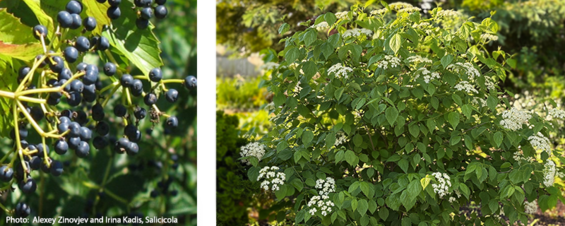
Arrowwood viburnum (Viburnum dentatum) is a dense, multi-stemmed shrub that typically grows 5 to 9 feet tall and wide. The branches are upright and spreading and arch at the tips. The leaves are either a shiny or flat dark green and turn yellow or red to red-purple in the late fall. The showy flowers are small, white, flattened clusters, which bloom late May to early June. The fruit, which can be an intense blue color, is ornamental and a food source for birds. Arrowwood is very easy to grow, being well adapted to full sun or partial shade and dry or fairly wet soils. Arrowwood is useful for its hardiness, as a border or screen, for naturalized plantings, to attract birds, and for difficult sites. This shrub is free from serious problems, with the only main maintenance requirement being an occasional rejuvenation pruning.
(Full sun to partial shade; dry to wet, well-drained soils; prefers slightly acidic soils; somewhat salt tolerant but best planted away from salt spray; deer and rabbit resistant; **** Availability Rating)
For more information, see:
- Lady Bird Johnson Wildflower Center’s Plant Database Page on Viburnum dentatum
- Salicicola’s Viburnum dentatum Plant Gallery
- United States Department of Agriculture’s Plant Fact Sheet on Southern Arrowwood (PDF, 68KB)
- University of Connecticut’s Plant Database Page on Viburnum dentatum
Barren Strawberry
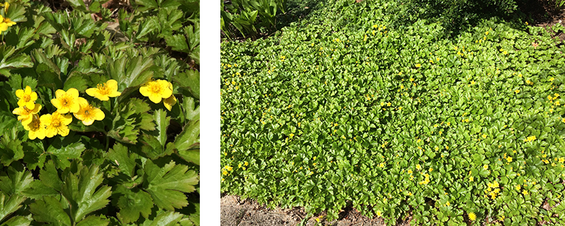
Appalachian barren strawberry (Geum fragarioides - also known as Waldsteinia fragarioides) is a hardy, sprawling evergreen plant 3-6 inches high with bright yellow flowers and strawberry-like leaves that turn a deep purplish bronze in the fall. Barren strawberry is a non-aggressive spreader, using its rhizomes to expand in a wide variety of conditions, including droughty soils, disturbed habitats, woodlands, and even floodplains of rivers and streams. The 5-petaled flowers bloom early in the spring and give way to the inedible berry-like achenes (that are not actually fruit). Barren strawberry can be successfully used in borders, rock gardens, native plant gardens, naturalized areas, and as a great substitute for lawn grasses. (introduced and naturalized in some coastal areas of Massachusetts)
(Full sun to full shade; dry to average, well-drained soils—tolerates a wide variety of soil conditions; drought tolerant; salt tolerant; deer and rabbit resistant; ** Availability Rating)
For more information, see:
- Go Botany’s Plant Page on Geum fragarioides
- Lady Bird Johnson Wildflower Center’s Plant Database Page on Waldsteinia fragarioides
- Native Plant Trust’s Plant Finder Page on Geum fragarioides
- Salicicola’s Geum fragarioides Plant Gallery
Bayberry
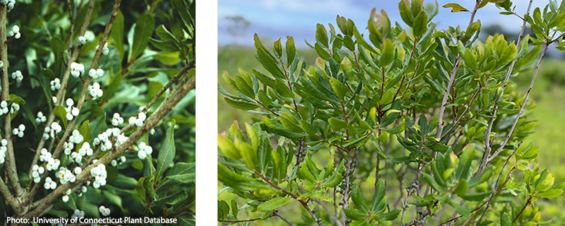
Bayberry (Morella caroliniensis, previously Myrica pensylvanica) is a woody shrub averaging 5 to 7 feet in height, with a thicket-forming character. The dark green leaves are aromatic and may stay on the branches for most of the winter. The flowers and white fruit (which are also aromatic) are somewhat inconspicuous, and the berries are a staple food for many species of wildlife (both male and female plants are necessary for cross pollination and berry production). The native bayberry is adapted to a wide variety of soil conditions, but does best on light-textured soils—it spreads naturally into bare sandy soils. Since it does form thickets, bayberry is useful for erosion control and wildlife shelter.
(Full sun to partial shade; dry to average, well-drained soils; drought tolerant; salt tolerant; deer and rabbit resistant; **** Availability Rating)
For more information, see:
- Lady Bird Johnson Wildflower Center’s Plant Database Page on Morella pensylvanica (synonym of Myrica)
- Salicicola’s Myrica pensylvanica Plant Gallery
- United States Department of Agriculture’s Plant Fact Sheet on Bayberry (PDF, 88 KB)
- University of Connecticut’s Plant Database Page on Myrica pensylvanica
Beach Heather
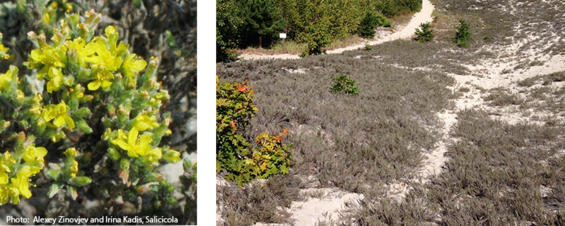
Beach heather (Hudsonia tomentosa) is a low-growing perennial shrub that thrives in nutritionally poor sand, therefore making it a dominant species in the dune ecosystem. Beach heather is beneficial for other plants because it enriches the soil with nitrogen. Beach heather has scaly leaves covered with fine, hair-like structures that protect the plant from moisture loss due to wind and sun. Off the tips of the branches grow clusters of bright yellow flowers. Beach heather functions to stabilize dunes with its carpet-like surface area that catches and holds the sand in place and a root network that binds the sediments.
(Full sun; dry, well-drained soils—prefers sandy soils; drought tolerant; salt tolerant; * Availability Rating)
For more information, see:
- Go Botany’s Plant Page on Hudsonia tomentosa
- Lady Bird Johnson Wildflower Center’s Plant Database Page on Hudsonia tomentosa
- Salicicola’s Hudsonia tomentosa Plant Gallery
- United States Department of Agriculture’s Plant Fact Sheet on Beach Heather (PDF, 153 KB)
Beach Plum
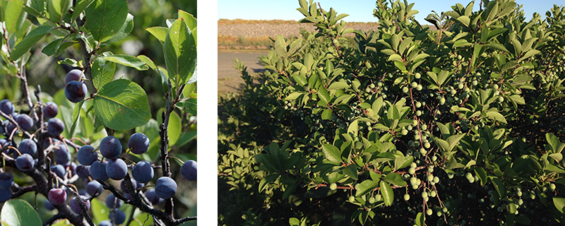
Beach plum (Prunus maritima) is a fast-growing, deciduous shrub with an average height of 4 to 7 feet, but can reach heights of 10 to 12 feet in inland, nutrient-rich soils. The plant, which is native to coastal areas of Massachusetts, is adapted to medium fertility, slightly acidic, loamy, and sandy soils. Over time, extensive colonies may develop from a single plant. In spring, snowy white flowers expand before the leaves, which are a dull-green color. The fruit ripens from August to October and can be harvested and processed into jam, syrup, and puree. Because of its tolerance of salt and its deep roots, beach plum is useful for stabilizing sand and landscaping a coastal dune.
(Full sun to partial shade; dry to average, well-drained soils—tolerates sandy soils; drought tolerant; salt tolerant; **** Availability Rating)
For more information, see:
- Go Botany’s Plant Page on Prunus maritima
- Lady Bird Johnson Wildflower Center’s Plant Database Page on Prunus maritima
- Salicicola’s Prunus maritima Plant Gallery
- University of Connecticut’s Plant Database Page on Prunus maritima
Bearberry
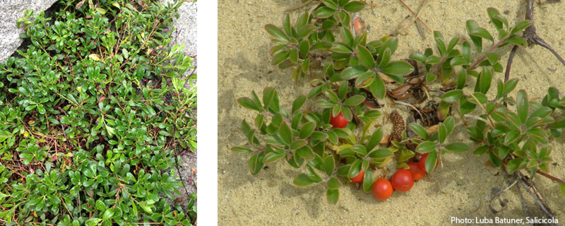
Bearberry (Arctostaphylos uva-ursi), with its leathery, dark, evergreen leaves, small white/pink urn-shaped flowers, bright red berries, and thick growing character, is a popular groundcover/low shrub choice. It grows 6 to 12 inches high and spreads from 3 to 6 feet wide. Over time, bearberry can spread by stem rooting to cover a very large area of up to 15 feet in diameter. The small flowers bloom from April to May and bright red fruits appear from August through the winter. The fruit is eaten by a few species of songbirds and other wildlife. Bearberry has the added benefit of being a very effective stabilizer of steep slopes or exposed areas. It is often planted around home sites, sand dunes, and sandy banks.
(Full sun to partial shade; dry to average, well-drained soils—tolerates sandy and rocky soils but not clay; prefers slightly acidic soils; does not tolerate being transplanted; drought tolerant; salt tolerant; deer and rabbit resistant; *** Availability Rating)
For more information, see:
- Go Botany’s Plant Page on Arctostaphylos uva-ursi
- Lady Bird Johnson Wildflower Center’s Plant Database Page on Arctostaphylos uva-ursi
- Salicicola’s Arctostaphylos uva-ursi Plant Gallery
- University of Connecticut’s Plant Database Page on Arctostaphylos uva-ursi
Bigleaf Hydrangea
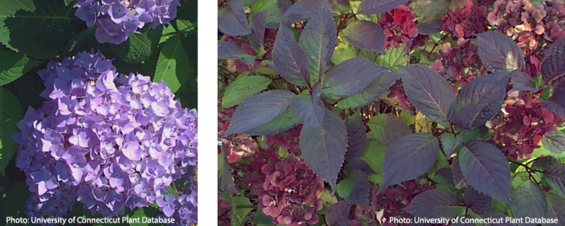
Bigleaf hydrangea (Hydrangea macrophylla) is a rounded deciduous shrub with stems that emerge from the ground. This shrub grows 3 to 6 feet tall and wide and has a fast growth rate. The leaves are 4 to 8 inches long, 3 to 6 inches wide, and have a medium-green color. The flowers can be pink, white, blue, or purple, depending on soil type—acidic soil produces blue flowers, alkaline produces pink. The individual flowers make a broad, showy corymb (flat flower head) and bloom July through August. The bigleaf hydrangea prefers morning sun, afternoon shade, and moist, well-drained soil. Because bigleaf hydrangea is tolerant of salt, it is useful for coastal landscapes. This shrub is also useful as a specimen plant, for groupings, and for foundation plantings. Maintenance requirements include that the plants be mulched, the stems be pruned after flowering, and young plants be protected in the winter. (not native; native to Japan)
(Partial sun to partial shade; average to moist, well-drained soils—tolerates sandy and clay soils; salt tolerant; **** Availability Rating)
For more information, see:
- iNaturalist’s Observation Page on Mophead Hydrangea
- Missouri Botanical Garden’s Plant Page on Hydrangea macrophylla
- University of Connecticut’s Plant Database Page on Hydrangea macrophylla
Black Chokeberry
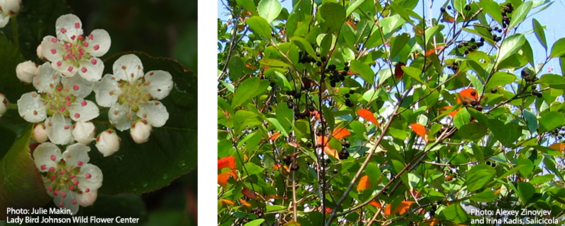
Black chokeberry (Aronia melanocarpa) is a hardy, multi-stemmed shrub that grows 3 to 6 feet in height and width and tends to form broad thickets. This shrub offers multi-seasonal qualities, including clusters of small white flowers in the spring, high-quality leaves in the summer, and persistent fruit and bright red foliage in the fall. The fibrous root system is very effective at holding soil and is therefore a good choice for erosion control. Black chokeberry is adaptable to many conditions, including sandy and rocky areas, dry or wet soils, and full sun or partial shade. Black chokeberry is not, however, considered drought tolerant. The chokeberries provide ornamental interest through much of winter because the fruit are very astringent to birds and won’t be eaten until other fruits are depleted. Chokeberries are edible by humans and are used in many recipes.
(Full sun to partial shade; dry to wet, well-drained soils—tolerates sandy, rocky, and clay soils; somewhat salt tolerant but best planted away from salt spray; deer and rabbit resistant; *** Availability Rating)
For more information, see:
- Go Botany’s Plant Page on Aronia melanocarpa
- Lady Bird Johnson Wildflower Center’s Plant Database Page on Aronia melanocarpa
- Salicicola’s Aronia melanocarpa Plant Gallery
- United States Department of Agriculture’s Plant Guide on Black Chokeberry (PDF, 68 KB)
Common Juniper
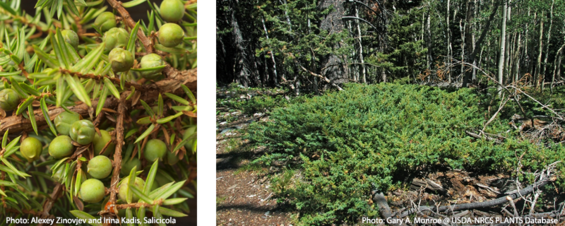
Common juniper (Juniperus communis) is a dense, native, evergreen tree or shrub that grows on dry, open, rocky, wooded hillsides, exposed slopes, and coastal banks and dunes. Though slow growing, it is extremely cold hardy and tolerant of difficult growing conditions, such as acidic sandy soils, sunny exposure, and wind. The common juniper variety depressa is a low-growing, mat-forming evergreen shrub that rarely exceeds 4 feet in height and 8 feet across. Root development can occur when branches come in contact with the ground. Other varieties of common juniper can grow as a tree and reach heights up to 25 feet. Common juniper is valued as an ornamental and is useful as a landscape groundcover, and the berry-like cones provide food for native birds.
(Full sun to partial shade; dry to moist, well-drained soils—tolerates a wide variety of soil types and conditions; drought tolerant; somewhat salt tolerant but best planted away from salt spray; deer and rabbit resistant; *** Availability Rating)
For more information, see:
- Go Botany’s Plant Page on Juniperus communis
- Lady Bird Johnson Wildflower Center’s Plant Database Page on Juniperus communis var. depressa
- Salicicola’s Juniperus communis var. depressa Plant Gallery
- University of Connecticut’s Plant Database Page on Juniperus communis
Eastern Ninebark
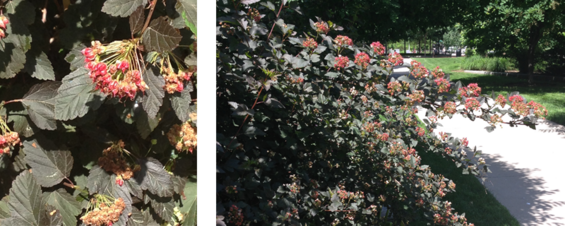
Eastern ninebark (Physocarpus opulifolius), or common ninebark, is a dense, mound-shaped, deciduous shrub that grows from 3 to 10 feet tall and 4 to 6 feet wide. The individual, white-to-pinkish, 5-petaled flowers that appear on flat-topped clusters from May to June give way to papery clusters of red fruit pods from August to early October. Ninebark is extremely hardy, drought-tolerant, and well adapted to a wide range of soil conditions, including moist to dry sites, gravel to clay textures, and partial shade to full sun. Ninebark is also fast growing and will resprout from the base vigorously if cut back. It can be used in a garden border, as a screen, or for erosion control on banks. The common name comes from the excessive peeling of the bark—as if it had nine layers or nine lives. The flowers are an excellent source of nectar for butterflies and bees, and the fruits are eaten by many species of birds. (not native; native to New York south to Florida and west to Colorado)
(Full sun to partial shade; dry to moist, well-drained soils—tolerates a wide variety of soils and occasional flooding; drought resistant; somewhat salt tolerant but best planted away from salt spray; deer and rabbit resistant; **** Availability Rating)
For more information, see:
- Go Botany’s Plant Page on Physocarpus opulifolius
- Lady Bird Johnson Wildflower Center’s Plant Database Page on Physocarpus opulifolius
- United States Department of Agriculture’s Plant Guide on Atlantic Ninebark (PDF, 78 KB)
- University of Connecticut’s Plant Database Page on Physocarpus opulifolius
Elderberry
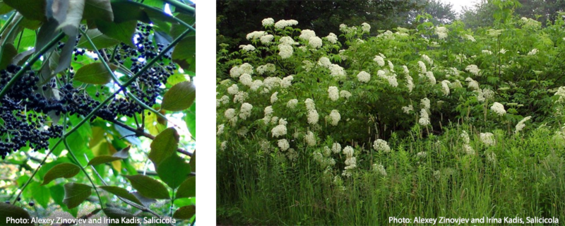
Elderberry (Sambucus canadensis), also known as American elder, is a fast-growing, thicket-forming, deciduous shrub that grows 4 to 12 feet high. Bright green, compound leaves grow on open, arching branches. The small, fragrant white flowers that bloom from late June to August are arranged on terminal clusters. The purple-black berries that ripen from July to September are eaten by at least 50 species of birds and mammals. Elderberry can tolerate a wide range of wet- to dry-soil conditions, but prefers rich, moist, slightly acidic soil and sunny locations. Elderberry is often found bordering streams and in wet forests but can be planted as a hedge or an accent or for effective erosion control on moist sites. The berries are inedible and slightly toxic to humans when raw, yet can be used for making jellies, preserves, pies, and wine.
(Full sun to partial shade; dry to wet, nutrient-rich, well-drained soils; prefers moist, slightly acidic soils; best planted away from salt spray; somewhat deer and rabbit resistant; *** Availability Rating)
For more information, see:
- Go Botany’s Plant Page on Sambucus nigra (synonym of canadensis)
- Salicicola’s Sambucus canadensis Plant Gallery
- United States Department of Agriculture’s Plant Fact Sheet on American Elder (PDF, 59 KB)
- University of Connecticut’s Plant Database Page on Sambucus canadensis
Fox Grape
Fox grape (Vitis labrusca) is a woody, deciduous vine that can reach 40 feet long with three-lobed, green leaves and tendrils that help it climb shrubs, trees, and other support structures. The small, greenish-yellow, spring blooms lead to drooping clusters of medium-sized, blue-black, edible grapes that ripen to dark purple later in the season. Fox grape is a vigorous climber both vertically and horizontally and the dense leafy cover provides nesting habitat for birds. The flowers are pollinated by bumblebees, honeybees, and long-horned and long-tongued bees, and many species of birds and mammals feed on the flavorful wild grapes and help to distribute the seeds to new locations. Many cultivated grapes are actually hybrids of fox grape, with the cultivars bearing larger fruits and the true natives offering a muskier (foxy) flavor of fruit, lending to its name.
(Full sun to partial shade—the more sun, the sweeter the fruit; average to moist, well-drained soils—can tolerate sandy or rocky soils and even flooding, if temporary; salt tolerant but best planted away from salt spray and wind; deer and rabbit resistant; ** Availability Rating)
For more information, see:
- Go Botany’s Plant Page on Vitis labrusca
- Lady Bird Johnson Wildflower Center’s Plant Database Page on Vitis labrusca
- Native Plant Trust’s Plant Page on Vitis labrusca
- Salicicola’s Vitis labrusca Plant Gallery
Gray Dogwood
Gray dogwood (Swida racemosa, previously known as Cornus racemosa) is a thicket-forming, deciduous shrub growing 10 to 15 feet tall and wide, with elliptical- or lance-shaped, blue-green leaves. In spring, round-topped clusters of creamy white flowers appear, which mature to white berries by late summer. Gray dogwood has smooth grey bark with some wart-like bumps, but both the flowers and fruit sit atop bright red fruit stalks that persist well into winter, adding seasonal interest. Gray dogwood tolerates a variety of soils and spreads by suckers to form multi-stemmed stands of shrubs, making it useful for erosion control, as a shrub border, or for more naturalized mass plantings. This dogwood can also effectively be used in rain gardens and as a valuable plant for wildlife—the flowers attract butterflies and the white fruits, which have a very high fat content, provide vital fuel for migrating birds and other wildlife.
(Full sun to partial shade—can tolerate full shade; medium to moist, well-drained soil—tolerant of wet or dry soils; salt tolerant but best planted away from salt spray and wind; deer resistant; **** Availability Rating)
For more information, see:
- Go Botany’s Plant Page on Swida racemosa
- Lady Bird Johnson Wildflower Center’s Plant Database Page on Cornus racemosa
- Native Plant Trust’s Plant Page on Swida racemosa
- Salicicola’s Swida racemosa Plant Gallery
Highbush Blueberry
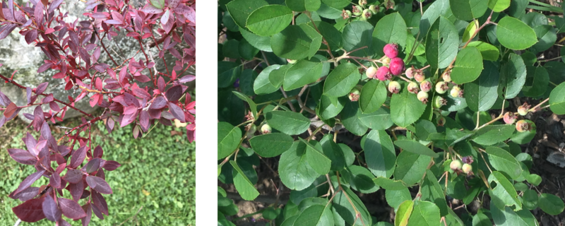
Highbush blueberry (Vaccinium corymbosum) is a native shrub that stands 6 to 12 feet tall and forms a crown. The flowers bloom in the spring and fruiting occurs from April to October. The berries provide food for many species of birds and mammals. Although the most common native habitat is in and around marshes, swamps, lakes, and flood-prone areas, highbush blueberry also occurs in drier areas, such as dunes and barrier beaches, rocky hillsides, and oak and pine woods. The plants grow in full sun to partial shade, but those in open sites produce more flowers and have brighter fall foliage color.
(Full sun to partial shade; medium to moist, nutrient-rich, well-drained soils; prefers acidic soils; somewhat salt tolerant but best planted away from salt spray; **** Availability Rating)
For more information, see:
- Go Botany’s Plant Page on Vaccinium corymbosum
- Lady Bird Johnson Wildflower Center’s Plant Database Page on Vaccinium corymbosum
- Salicicola’s Vaccinium corymbosum Plant Gallery
- University of Connecticut’s Plant Database Page on Vaccinium corymbosum
Inkberry
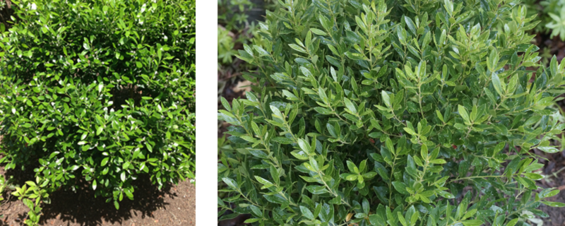
Inkberry (Ilex glabra) is a long-living, evergreen shrub that typically grows from 6 to 12 feet high. It has dark green, leathery leaves; small, inconspicuous, greenish-white flowers that bloom March through June; and small, black-blue fruit that appears September through October and persists into the following spring (both male and female plants are necessary for cross pollination and berry production). Inkberry is shade tolerant and grows on a variety of soil types, including both dry and wet sites, and on sandy and heavier, peaty soils. Inkberry spreads by rhizomes and can form clusters and dense thickets. It is useful for shrub borders, foundation plantings, or as a low hedge, and because it also displays a high degree of salt tolerance, is useful in coastal gardens. Because of its ability to perform well in wet sites, it is also excellent for moist woodland gardens or riparian areas. Periodic pruning is recommended to lower the height and rejuvenate this shrub, due to its tendency to get leggy.
(Full sun to partial shade; dry to moist, well-drained soils—tolerates wet, acidic soils; salt tolerant but best planted away from salt spray and wind; deer and rabbit resistant; **** Availability Rating)
For more information, see:
- Go Botany’s Plant Page on Ilex glabra
- Lady Bird Johnson Wildflower Center’s Plant Database Page on Ilex glabra
- Salicicola’s Ilex glabra Plant Gallery
- University of Connecticut’s Plant Database Page on Ilex glabra
Large Cranberry
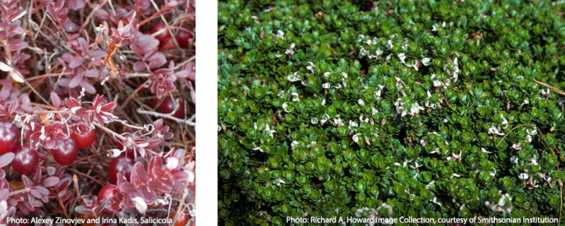
Large cranberry (Vaccinium macrocarpon) is a low-growing vine or trailing shrub that typically grows 4 to 8 inches high and 3 to 4 feet wide. The evergreen leaves are small, leathery, and green in the summer and turn a variety of colors in the fall. The spring flowers yield tart, edible, red fruit from June through August. Cranberry is typically found in wet bogs or swamps with damp, acidic, peaty, well-drained soils. Due to its extensive creeping rhizomes, this plant often forms low, dense mats. Provided with enough moisture and organic matter, cranberry plants can be planted as a low groundcover or as an accent in a shrub or perennial border.
(Full sun; moist to wet soils; prefers acidic soils; best planted away from salt spray and wind; deer and rabbit resistant; ** Availability Rating)
For more information, see:
- Go Botany’s Plant Page on Vaccinium macrocarpon
- Lady Bird Johnson Wildflower Center’s Plant Database Page on Vaccinium macrocarpon
- Missouri Botanical Garden's Plant Page on Vaccinium macrocarpon
- Salicicola’s Vaccinium macrocarpon Plant Gallery
Lowbush Blueberry
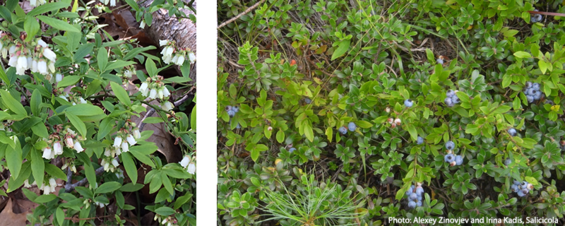
Lowbush blueberry (Vaccinium angustifolium) is a deciduous, twiggy shrub growing 6 inches to 2 feet tall and 2 feet wide. This groundcover has a dark green leaf color, which turns to a brilliant bronze or red in the fall. The urn-shaped, white flowers bloom in May and the bluish-black fruit, which matures in mid- to late-summer, is edible. Lowbush blueberry requires moist soil that is high in organic matter, with a very acidic pH. Sandy soils with adequate moisture will support good growth. Lowbush blueberry thrives in full sun to partial shade, although more sun will produce more blooms and more fruit. Lowbush blueberry is valued for its edible fruit, ability to attract wildlife, and attractive fall color. It can be useful in the landscape as a shrub border and as naturalized plantings.
(Full sun to partial shade; dry to moist, nutrient-rich, well-drained soils; prefers acidic soils; drought tolerant; salt tolerant but best planted away from salt spray and wind; **** Availability Rating)
For more information, see:
- Go Botany’s Plant Page on Vaccinium angustifolium
- Lady Bird Johnson Wildflower Center’s Plant Database Page on Vaccinium angustifolium
- Salicicola’s Vaccinium angustifolium Plant Gallery
- University of Connecticut’s Plant Database Page on Vaccinium angustifolium
Marsh Elder
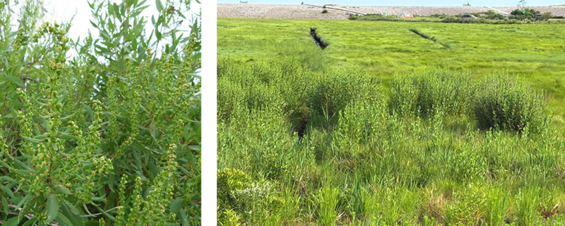
Marsh elder (Iva frutescens), also known as Jesuit's bark, is a perennial, multi-stemmed, deciduous subshrub (short woody plant) that grows from 3 to 8 feet high. It has lance-shaped, succulent leaves and prominent, greenish-white flower heads that appear in the late summer. Marsh elder most often grows in mid to high salt marsh ecosystems, tidelands, and back dune areas, at elevations where the roots are not subject to prolonged flooding. Though adaptable to various soil textures, marsh elder requires moist, saline soils and is not very shade or drought tolerant. Once established, however, it is very low maintenance. Marsh elder is very effective on coastal sites where few other plants will grow. It provides nesting habitat for birds and can serve as shelter for small mammals, particularly during extreme high tides.
(Full sun; moist to wet, saline soils; salt tolerant; * Availability Rating)
For more information, see:
- Go Botany’s Plant Page on Iva frutescens
- Lady Bird Johnson Wildflower Center’s Plant Database Page on Iva frutescens
- Salicicola’s Iva frutescens Plant Gallery
- United States Department of Agriculture’s Plant Fact Sheet on Marsh Elder (PDF, 54 KB)
Nannyberry
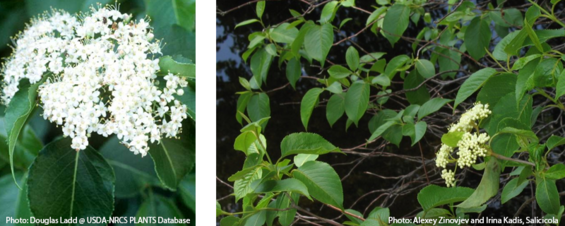
Nannyberry (Viburnum lentago) is a native, deciduous, multi-stemmed shrub or small tree (if pruned) that may reach up to 36 feet in height. The leaves, which are 2 to 4 inches long, are dark, glossy green at maturity and change to red in the fall. The small, white flowers that form in a flat-top cluster appear in May through June, and the blue-black, berry-like fruits appear in July through September. Nannyberry is adaptable to a wide range of sites, including moist areas, low woods, or near stream banks, but it also tolerates drier sites. This shrub is a shade-tolerant understory species and is useful in shrub borders, hedges, and windbreaks. The fruits are sweet and edible and are eaten by many species of birds and wildlife.
(Full sun to shade; dry to moist, well-drained soils—tolerant of a variety of soil types; drought tolerant; best planted away from salt spray; somewhat deer and rabbit resistant; **** Availability Rating)
For more information, see:
- Go Botany’s Plant Page on Viburnum lentago
- Lady Bird Johnson Wildflower Center’s Plant Database Page on Viburnum lentago
- United States Department of Agriculture’s Plant Fact Sheet on Nannyberry (PDF, 92 KB)
- University of Connecticut’s Plant Database Page on Viburnum lentago
New Jersey Tea
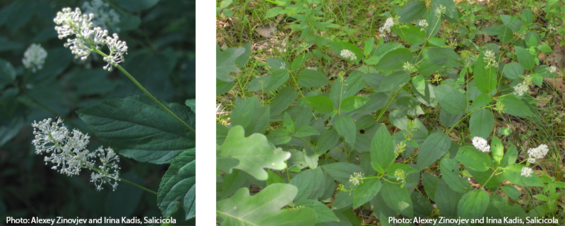
New Jersey tea (Ceanothus americanus) is a shrubby, native, deciduous perennial that grows 3 to 4 feet high and 3 to 5 feet wide. This plant produces multiple, light green stems and toothed, medium-to-dark green leaves up to 4 inches long. Young twigs are yellow and stand out in winter. New Jersey tea grows best in full or partial sun and average to slightly dry conditions. New Jersey tea is resistant to drought, shriveling under dry conditions, but quickly reviving with the next rainfall. Numerous Native American tribes used New Jersey tea as a beverage and American colonists commonly used this plant as a tea substitute during the Revolutionary War.
(Full sun to partial shade; dry to average, well-drained soils—prefers sandy and rocky soils; drought tolerant; best planted away from salt spray; ** Availability Rating)
For more information, see:
- Go Botany’s Plant Page on Ceanothus americanus
- Lady Bird Johnson Wildflower Center’s Plant Database Page on Ceanothus americanus
- Salicicola’s Ceanothus americanus Plant Gallery
- United States Department of Agriculture’s Plant Fact Sheet on New Jersey Tea (PDF, 100 KB)
Red Chokeberry
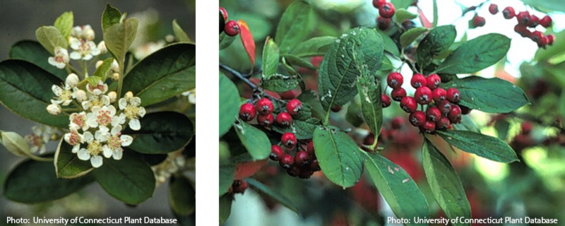
Red chokeberry (Aronia arbutifolia) is native throughout most of the eastern United States and is found in various habitats from dry hillsides to wetland areas. This deciduous shrub grows from 6 to 10 feet tall and 3 to 5 feet wide. It is a suckering, spreading, colonizing shrub with numerous, slender stems. Red chokeberry is tolerant of partial shade and of both dry and wet sites. It can be transplanted easily and is valued for its summer flowers, persistent fruit, and colorful fall foliage. It is useful for naturalistic plantings, bank and dune stabilization, colonization and mass plantings, or borders in a garden.
(Full sun to partial shade; dry to moist, well-drained soils—tolerates a wide variety of soil conditions; drought tolerant; salt tolerant but best planted away from salt spray and wind; deer and rabbit resistant; *** Availability Rating)
For more information, see:
- Go Botany’s Plant Page on Aronia arbutifolia
- iNaturalist’s Observation Page on Red Chokeberry
- Lady Bird Johnson Wildflower Center’s Plant Database Page on Aronia arbutifolia
- University of Connecticut’s Plant Database Page on Aronia arbutifolia
Red Twig Dogwood, Red-osier Dogwood
Red twig dogwood, red-osier dogwood (Swida sericea, previously known as Cornus sericea) is a multi-stemmed, deciduous shrub that grows to a height and width of 6 to 9 feet and spreads by root suckering to form colonies. Dense clusters of flat-topped, creamy white flowers appear in mid-to late spring/early summer, followed by blue-tinged white berries that last into the fall and are a food source for songbirds. The smooth, green leaves, which turn shades of orange-red to purple in the fall, eventually drop off, leaving the conspicuous and showy, bright red stems that provide beautiful winter color to the landscape. (The brightest color occurs on new stem growth; pruning the plant back in early spring will stimulate more growth.) This dogwood’s ability to spread quickly makes it a useful shrub for erosion control, stabilizing streambanks, and revegetating wetlands. Red twig dogwood is a larval host for butterflies, including the spring azure moth, and its dense branching provides good cover for a variety of small wildlife.
(Full sun to partial shade—more sun leads to more vibrant stem color; moist, well-drained, nutrient-rich soils—tolerates wet areas; adaptable to drier conditions once established; somewhat salt tolerant but best planted away from salt spray and wind; **** Availability Rating)
For more information, see:
- Go Botany’s Plant Page on Swida sericea
- Lady Bird Johnson Wildflower Center’s Plant Database Page on Cornus sericea
- Native Plant Trust’s Plant Page on Swida sericea
- Salicicola’s Swida sericea Plant Gallery
Shrubby Cinquefoil
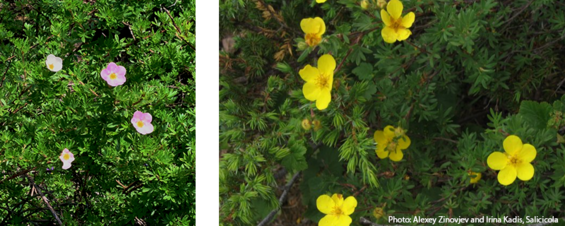
Shrubby cinquefoil (Potentilla fruticosa), also known as bush cinquefoil, is a deciduous shrub that typically grows 2 to 4 feet high and has a mound-shaped form and compound pinnate leaves. The five-petaled, bright-yellow flowers have a long blooming period, often appearing in the spring and continuing through early fall. Though shrubby cinquefoil does best in fertile, medium moisture, well-drained soils in full sun, established plants grow well in a wide range of conditions, are fairly resistant to drought and saline soils, and are tolerant of some shade. Shrubby cinquefoil is also very tolerant of cold. The dense growth of this shrub provides cover for wildlife, the seed capsules provide fall and winter food for birds, and the flowers provide an excellent source of nectar for bees and butterflies. The variety ‘Pink Beauty’ is shown in the photograph on the left.
(Full sun to partial shade; dry to moist, well-drained soils—tolerates a wide variety of soil conditions; drought tolerant; salt tolerant but best planted away from salt spray and wind; deer and rabbit resistant; ** Availability Rating)
For more information, see:
- Go Botany’s Plant Page on Dasiphora floribunda (synonym of Potentilla fruticosa)
- Lady Bird Johnson Wildflower Center’s Plant Database Page on Dasiphora fruticosa (synonym of Potentilla fruticosa)
- Salicicola’s Potentilla fruticosa ssp. Floribunda Plant Gallery
- University of Connecticut’s Plant Database Page on Potentilla fruticosa
Spicebush
Spicebush (Lindera benzoin) is a deciduous, understory shrub, growing 6 to 12 feet high and wide, with spicy, citrusy aromatic leaves and twigs. Before the glossy green leaves appear, clusters of small, greenish-yellow flowers arise early in the spring and mature to red summer fruits in the fall that are eaten by many species of birds (both male and female plants are necessary for cross pollination and fruit production). Spicebush is fast growing and useful in moist, shady places, though some sun will lead to better form and flowering. Both the yellow spring flowers and golden yellow fall foliage brighten forest edge and open woodland areas. Spicebush is a host plant for swallowtail butterfly caterpillars.
(Full sun to full shade—more sun leads to better form and fruit; average to wet, well-drained soils; slightly salt tolerant but best planted away from salt spray and wind; deer and rabbit resistant; *** Availability Rating)
For more information, see:
- Go Botany’s Plant Page on Lindera benzoin
- Lady Bird Johnson Wildflower Center’s Plant Database Page on Lindera benzoin
- Native Plant Trust’s Plant Page on Lindera benzoin
- Salicicola’s Lindera benzoin Plant Gallery
Sweet Fern
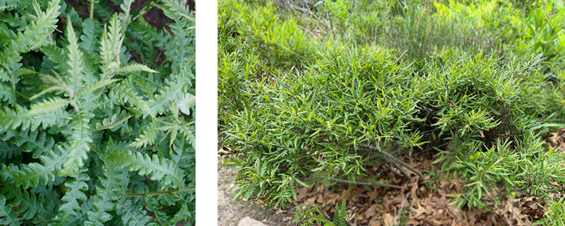
Sweet fern (Comptonia peregrina) is a low-growing, deciduous native shrub that is 2 to 4 feet in height, with sweet-scented, fern-like leaves that are particularly aromatic when crushed. Sweet fern is a loosely branched, spreading, and colonizing plant. The flowers are small, inconspicuous catkins that bloom from April to May. Sweet fern is extremely cold hardy and prefers acidic, sandy, or peaty soils with low fertility, but does not tolerate shading. Sweet fern produces many underground stems or rhizomes, making it an effective groundcover for erosion control on steep, sandy banks and for species diversity in sterile, sandy soils.
(Full sun to partial shade; dry to moist, well-drained soils—prefers acidic, sandy soils and tolerates wet and nutrient-poor soils; drought tolerant; salt tolerant; deer and rabbit resistant; *** Availability Rating)
For more information, see:
- Go Botany’s Plant Page on Comptonia peregrina
- Lady Bird Johnson Wildflower Center’s Plant Database Page on Comptonia peregrina
- Salicicola’s Comptonia peregrina Plant Gallery
- University of Connecticut’s Plant Database Page on Comptonia peregrina
Sweet Pepperbush
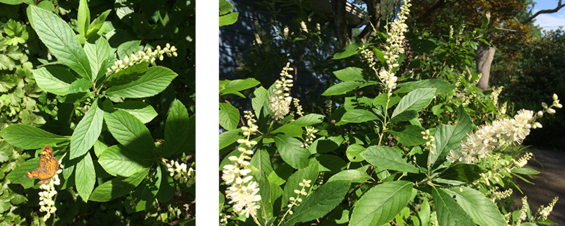
Sweet pepperbush (Clethra alnifolia), also known as summer sweet, is a deciduous, upright, multi-stemmed shrub that grows from 6 to 12 feet high. The fragrant, bottlebrush-like flower spikes, which appear in July and August and last up to 6 weeks or more, are followed by tiny, brown seed capsules that persist through winter. Sweet pepperbush is moderately salt tolerant, highly shade tolerant, and well adapted to poorly drained, moist soils, though it can also do well on drier, well drained sites once established. The thicket-forming character of sweet pepperbush is useful for providing erosion control along embankments, streams, and ponds, and its adaptability to wet areas makes it a good plant for low spots, rain gardens, and stream banks. Sweet pepperbush is also very useful as a garden plant, shrub border, or foundation plant, particularly if pruned to size. The fragrant flowers and nectar attract hummingbirds and butterflies and the seeds are eaten by birds and mammals.
(Full sun to full shade; average to wet, well-drained soils—tolerates a wide variety of conditions, including occasional flooding; prefers slightly acidic, sandy soils; somewhat drought tolerant; somewhat salt tolerant; deer and rabbit resistant; **** Availability Rating)
For more information, see:
- Go Botany’s Plant Page on Clethra alnifolia
- Lady Bird Johnson Wildflower Center’s Plant Database Page on Clethra alnifolia
- United States Department of Agriculture’s Plant Guide on Coastal Sweet Pepperbush (PDF, 186 KB)
- University of Connecticut’s Plant Database Page on Clethra alnifolia
Virginia Creeper
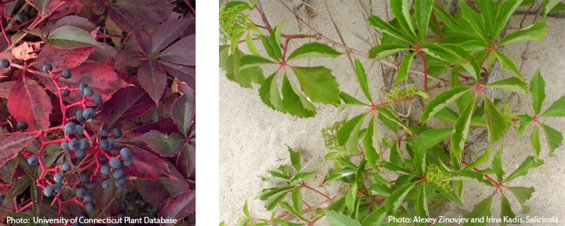
Virginia creeper (Parthenocissus quinquefolia) is a woody, deciduous vine that can climb to heights up to 100 feet on trees or other tall structures or form a dense ground cover. This vigorously growing vine climbs by means of tendrils with disks that fasten onto the host surface. The ornamental, five-part leaves emerge purplish in spring, mature to green in summer, and change to purple or mauve/red in fall. Virginia creeper is fairly shade tolerant and salt tolerant and can thrive in a wide range of soil types, including the dry conditions found on coastal dunes. Though it has a rather open canopy, Virginia creeper can be useful as an erosion control measure because of its sprouting and spreading character. Virginia creeper also provides cover for many small birds and mammals and the blue berries that appear in August to October are eaten by songbirds. (Note: The berries are highly toxic to humans and may be fatal if eaten.)
(Full sun to partial shade; dry to average, well-drained soils—tolerates a wide variety of conditions, including sandy alkaline soils; somewhat drought tolerant; somewhat salt tolerant; deer and rabbit resistant; ** Availability Rating)
For more information, see:
- Go Botany’s Plant Page on Parthenocissus quinquefolia
- Lady Bird Johnson Wildflower Center’s Plant Database Page on Parthenocissus quinquefolia
- Salicicola’s Parthenocissus quinquefolia Plant Gallery
- University of Connecticut’s Plant Database Page on Parthenocissus quinquefolia
Virginia Rose
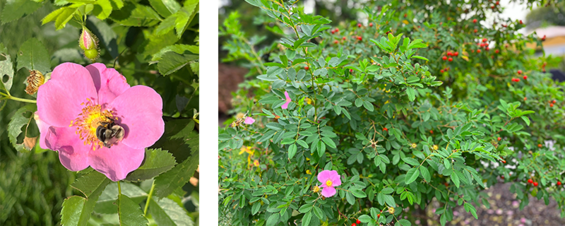
Virginia rose (Rosa virginiana) is a native shrub, growing 2 to 6 feet high, with many spreading branches, thorny stems, and attractive flowers. The dark green, toothed leaves turn purplish-red in the fall. The fragrant 2- to 3-inch diameter flowers are pink with yellow centers and bloom from June through August. Many insects that visit the rose blooms for nectar help pollinate the flowers that later become rose hips. The ½- inch-wide rose hips stay on the plant through winter, are edible, are high in Vitamin C and essential fatty acids, are a good food source for many animals, and can be used to make teas and medicines. Virginia rose prefers full sun and well-drained, acidic soil (but can also survive in moist soils). Virginia rose is easy to transplant and grow, is tolerant of salt, and does well under winter conditions, making it a good specimen for seaside planting. The thicket-forming character provides a great hedge and good cover for birds and other animals.
(Full sun; dry to average, well-drained soils—tolerant of poor, sandy soils; prefers slightly acidic soils; drought tolerant; salt tolerant; *** Availability Rating)
For more information, see:
- Go Botany’s Plant Page on Rosa virginiana
- Lady Bird Johnson Wildflower Center’s Plant Database Page on Rosa virginiana
- Salicicola’s Rosa virginiana Plant Gallery
- University of Connecticut’s Plant Database Page on Rosa virginiana
Wild Raisin
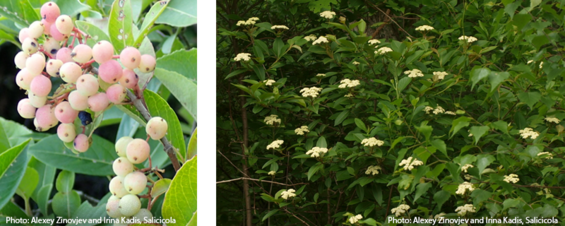
Wild raisin (Viburnum nudum var. cassinoides, formerly Viburnum cassinoides), also known as northern wild raisin, witherod viburnum, or possumhaw, is a dense, multi-stemmed, deciduous shrub that grows 6 to 12 feet high. The showy, fragrant, white flowers are arranged in flat-topped clusters and bloom in the spring and early summer. The fruit that follows is pink/red in the summer, blue in late summer, black by fall, and will remain on the shrub even after the foliage has fallen. The foliage of the shrub also provides attractive fall color. Wild raisin is commonly found in swamps or moist upland woods and clearings and is more tolerant of wet soils than other viburnums. This shrub is relatively shade tolerant, but not salt tolerant. The fruit attracts songbirds, shorebirds, and mammals and is also edible by humans. This shrub is useful along wetlands or pond edges, or as a foundation plant, screen, windbreak, or hedge barrier.
(Full sun to partial shade; average to wet soils; tolerates a wide variety of soil types, including sand and clay; prefers slightly acidic soils; best planted away from salt spray; somewhat deer and rabbit resistant; *** Availability Rating)
For more information, see:
- Go Botany’s Plant Page on Viburnum nudum
- Lady Bird Johnson Wildflower Center’s Plant Database Page on Viburnum nudum var. cassinoides
- Salicicola’s Viburnum nudum var. cassinoides Plant Gallery
- University of Connecticut’s Plant Database Page on Viburnum cassinoides
Wild Strawberry
Virginia strawberry or wild strawberry (Fragaria virginiana) is a ground-hugging, patch-forming plant with fibrous roots and an ability to spread easily by runners. Looking much like the cultivated strawberry plant, wild strawberry has toothed, trifoliate leaves, loose clusters of small, white, five-petaled flowers that bloom in the spring, and edible strawberries that appear in summer. Wild strawberry fruits are much smaller than the cultivated varieties but have a sweeter flavor. In fall, the low-growing foliage turns shades of maroon and red. With its vigorous growth and adaptability to a variety of soils, along with the ability to outcompete invasive species and tolerate foot traffic, wild strawberry is a valuable groundcover and useful for erosion control or as a low-maintenance alternative to lawn. Wild strawberry also supports wildlife, supplying food for many caterpillars and nectar for numerous pollinators.
(Full sun to partial shade; dry to average, well-drained soils—prefers sandy soils; drought tolerant; deer and rabbit resistant; *** Availability Rating)
For more information, see:
- Go Botany’s Plant Page on Fragaria virginiana
- Lady Bird Johnson Wildflower Center’s Plant Database Page on Fragaria virginiana
- Native Plant Trust’s Plant Page on Fragaria virginiana
- Salicicola’s Fragaria virginiana Plant Gallery
Winged Sumac
Winged sumac, shining sumac (Rhus copallinum) is a deciduous, suckering shrub that grows 7 to 15 feet tall and wide, with long, shiny, compound leaves (with 7 to 21 leaflets), unique wings along the leafstalks, and outstanding red, crimson, and scarlet fall foliage. Lacy, yellow-green flowers that form on dense panicles bloom in July and August and ripen into edible, yet sour, red berries in August. Both male and female plants are needed to produce the fruit, which remains on the shrub through winter, providing a late-season food source for birds and other wildlife. This sumac thrives on poor, dry soils, including in coastal settings, along stream banks, and on dry rocky headlands. Given its ability to spread to form colonies and its tolerance for salt spray and wind, winged sumac can be useful for erosion control along the coast and in other naturalistic settings where space is available. This low-maintenance sumac can also be used as a screen (where growth can be controlled by cutting back plants to a desired height) and as a specimen tree (where suckers can be cut to promote the growth of a single tree). Winged sumac is a host plant for the red-banded hairstreak caterpillar and the luna moth, and the flowers attract numerous pollinators, including bees and butterflies.
(Full sun—relatively intolerant of shade; dry to average, well-drained soils—tolerates sandy, rocky, and clay soils; drought tolerant; salt tolerant; deer and rabbit resistant; ** Availability Rating)
For more information, see:
- Go Botany’s Plant Page on Rhus copallinum
- Lady Bird Johnson Wildflower Center’s Plant Database Page on Rhus copallinum
- Native Plant Trust’s Plant Page on Rhus copallinum
- Salicicola’s Rhus copallinum Plant Gallery
Winterberry
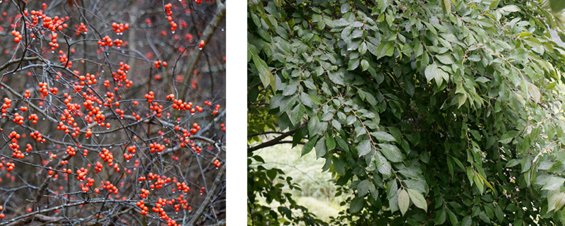
Winterberry (Ilex verticillata) is a medium-sized, multi-stemmed, deciduous shrub that grows to heights of 5 to 15 feet. The smooth, sharply toothed leaves are dark green in summer, turn yellow in autumn, and fall off by mid-October. The highlight of this shrub is the densely packed, bright scarlet-red berries that mature in late summer and persist through the winter (both male and female plants are necessary for cross pollination and berry production). The striking berries on bare stems make an attractive fall and winter display (if not thoroughly foraged by animals). The fruit, though eaten by many species of birds and mammals, is poisonous to humans. Winterberry is tolerant of a wide range of soil conditions, including wet soils, making it effective in a rain garden.
(Full sun to partial shade—more sun leads to better fruiting; average to wet, well-drained soils; tolerates poorly drained soils; prefers acidic soils; best planted away from salt spray; **** Availability Rating)
For more information, see:
- Go Botany’s Plant Page on Ilex verticillata
- Lady Bird Johnson Wildflower Center’s Plant Database Page on Ilex verticillata
- United States Department of Agriculture’s Plant Fact Sheet on Winterberry (PDF, 55 KB)
- University of Connecticut’s Plant Database Page on Ilex verticillata
A Note on Rosa Rugosa
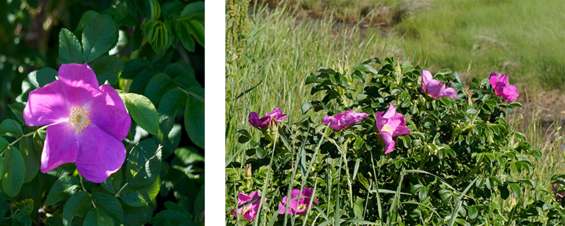
Rugosa rose (Rosa rugosa) is considered to be non-native (native to eastern Asia) and potentially invasive in some regions or habitats of Massachusetts and may displace desirable vegetation if not properly managed. Though the shrub is extremely tolerant of sea spray and effective at directing pedestrian access away from dunes, it has the ability to form dense thickets that shade and outcompete other native bank, beach, and dune plants. Rugosa rose can also spread vigorously through both seed dispersal (carried by the rose hips) and underground rhizomes. Therefore, care should be taken when considering planting rugosa rose on coastal properties.
Availability Rating Key
**** - Widely available at large commercial garden centers, as well as at specialty nurseries and through online purchase.
*** - Widely available at specialty nurseries and through online purchase, but only occasionally found at garden centers.
** - Occasionally available at specialty nurseries and through online purchase and difficult to find at garden centers.
* - Selectively available through specialty nurseries and through online purchase and difficult to find at garden centers.
See Where to Purchase Native Plants for Massachusetts nurseries and online options. If you cannot find a plant you are interested in, contact your local garden center and other outlets to help encourage future availability.